
- •В.П. Сімонок
- •Contents
- •Передмова
- •Структура підручника
- •Degrees of Comparison of Adjectives and Adverbs
- •Indefinite (Simple) Tense
- •Reading rules
- •Grammar
- •(Речення з дієсловом to have (have got))
- •Degrees of Comparison of Adjectives and Adverbs
- •Порівняльні сполучники та звороти
- •Nouns: Countable and Uncountable Plural and Singular
- •Indefinite (Simple) Tense
- •Present Indefinite (Simple) Tense
- •Past Indefinite (Simple) Tense
- •Future Indefinite (Simple) Tense
- •Reading and discussion Active Vocabulary
- •Irregular verbs
- •From the history of railways:
- •200 Years of progress
- •Conversational practice
- •At the Railway Ticket Office
- •Word building
- •Enjoy yourself
- •Reading rules
- •Grammar Possessive Case of Nouns
- •Articles
- •Imperative Sentences
- •Prepositions of Time
- •Prepositions of Place
- •Questions General Questions
- •Special Questions
- •Alternative Questions
- •Tag Questions
- •Indefinite (Simple) Tense in the Passive
- •Reading and discussion Active Vocabulary
- •Irregular verbs
- •Exercise 49 Pre-reading discussion.
- •Railway traffic operation
- •Supplementary text railroading begins
- •Conversational practice
- •I’m sorry Excuse me of course Pardon
- •Word building
- •Enjoy yourself
- •Grammar Continuous Tense
- •Present Continuous Tense
- •Past Continuous Tense
- •Future Continuous Tense
- •Verbs, used only in simple tenses
- •Pronouns
- •Numerals
- •Розміри, виміри
- •Номери телефонів, автобусів та ін.
- •Reading and discussion Active Vocabulary
- •Irregular verbs
- •The railroad track
- •Unusual railways
- •It’s interesting to know... Around the world: track innovations
- •Conversational practice
- •I’ll ring back later.
- •I’m having a party on Saturday. Can you come?
- •Grammar revision
- •The Tower of London
- •Enjoy yourself
- •Grammar Perfect Tense (Часи групи Perfect)
- •Present Perfect Tense
- •Past Perfect Tense
- •Future Perfect Tense
- •The Loch Ness Wallet
- •Perfect Continuous Tense
- •Present Perfect Continuous Tense
- •Past Perfect Continuous Tense
- •Future Perfect Continuous Tense
- •Reading and discussion Active Vocabulary
- •Irregular verbs
- •Underground railways
- •Kharkiv underground
- •It is interesting to know... News in Brief about World Metros
- •Conversational practice
- •Grammar revision
- •Enjoy yourself
- •Reading rules
- •Grammar Sequence of Tenses
- •Виключення з правила узгодження часів
- •Direct and Reported Speech
- •Питальні речення у непрямій мові
- •The Stress Interview
- •Interview
- •Наказові речення у непрямій мові
- •Expressions of Quantity Вираження кількості
- •Reading and discussion Active Vocabulary
- •Irregular verbs
- •Railway construction: tunnels and bridges
- •Various types of passenger stock
- •Freight cars and containers
- •Conversational practice
- •Word building
- •Exercise 46 Translate the adjectives.
- •Grammar review
- •Amazing but true!
- •Enjoy yourself
- •Father’s Motto
- •Compound Forms of Present Participle
- •Supplementary text: New Energy from Old Sources
- •Reading rules
- •Exercise 1 Read the following word groups.
- •Exercise 2 Read the following words.
- •Grammar Present Participle and Past Participle
- •Use of Participles
- •Compound Forms of Present Participle
- •Exercise 19 Translate the word combinations using participles.
- •Absolute Participle Construction
- •Compound Sentences Types of Subordinate Clauses
- •Reading comprehension Active Vocabulary
- •Irregular verbs
- •Power supply system
- •Exercise 40 Answer the questions.
- •Exercise 41 Replace the italicised words with the synonyms from the text.
- •Exercise 42 Find the words from which the following derivatives are produced.
- •Is connected, float, to convert
- •Exercise 46 Match the words and their definition
- •Supplementary Text new energy from old sources
- •Exercise 52 Work in pairs. Make a list of things we take for granted in our daily lives that would not be possible without electricity. Exchange your list with those of other members of the group.
- •It’s interesting to know…
- •Conversational practice
- •Grammar revision
- •Enjoy yourself
- •Travelling by train
- •Reading rules
- •Grammar Gerund
- •Функції герундія
- •It takes your breath away!
- •Exercise 12 Translate the following sentences paying attention to the use of that.
- •Shall / Will
- •Irregular verbs
- •New technologies on world railways
- •Computer Crime
- •Conversational practice
- •Word building
- •Grammar revision
- •Enjoy yourself
- •Reading rules
- •Grammar
- •Infinitive
- •Форми інфінітива
- •Функції інфінітива
- •Exercise 4 Translate the following sentences and word combinations.
- •Exercise 5 Translate the sentences defining the function of the Infinitive.
- •The Brave Old Lady and the Hopeless Crook1
- •Attributive Group
- •Exercise 14 Find the headword of the word combinations and translate them.
- •Reading and discussion Active Vocabulary
- •Irregular verbs
- •High speed rail
- •500 Series Shinkansen
- •Supplementary Text a High-speed Trains Versus Automobiles and Airplanes
- •What is maglev?
- •Russian / German High-Speed Pact
- •Conversational practice
- •Word building
- •Exercise 35 Translate the following sentences.
- •Compound words
- •Grammar revision
- •Enjoy yourself
- •Phrasal Verbs
- •Reading rules
- •Grammar Complex Object
- •Exercise 3 Translate the sentences paying attention to the Complex Object.
- •Exercise 9 Translate the sentences using the Complex Object.
- •Complex Subject (Суб’єктний інфінітивний зворот)
- •Exercise 14 Translate the sentences using the Complex Subject.
- •An Overheard Conversation
- •Phrasal Verbs
- •The Art of Feng Shui
- •Reading comprehension Active Vocabulary
- •Irregular verbs
- •Railway transport economics
- •Exercise 35 Answer the following questions according to the text.
- •Exercise 36 Find English equivalents.
- •Logistics on the Move
- •Word building
- •Enjoy yourself
- •The Song of the Engine
- •Three Types of Conditional Sentences
- •Reading rules
- •Grammar Subjunctive Mood
- •3. Past Indefinite або Past Perfect.
- •Three Types of Conditional Sentences
- •Emphasis
- •Inversion
- •Exercise 27 Let’s talk about writers (artists, composers, etc.) both classical and modern. Express your opinion on Tolstoy, Shevchenko, Levitan, Mozart, etc.
- •Compound Conjunctions (Складові сполучники)
- •Compound Prepositions (Складові прийменники)
- •Reading and discussion Active Vocabulary
- •Irregular verbs
- •The future of rail transportation
- •Four Eurasian Corridors
- •Russia proposes Bering Strait tunnel
- •Conversational practice
- •Word building
- •Grammar revision
- •Enjoy yourself
- •Thoughts, that help us live
- •Irregular Verbs
- •Фонетичні правила читання голосних
- •Порядок слів у стверджувальному реченні
- •Active Voice
- •Passive Voice
- •Pronouns
- •Functions of Modal Verbs and Synonymous Expressions
- •Prepositions after Particular Words and Expressions
- •Greetings
- •Getting Acquainted with People
- •Parting with People
- •Invitations and Proposals
- •Apologies
- •Answers
- •Agreeing
- •Disagreeing
- •Hesitations and Lack of Understanding
- •Starting a Conversation
- •Telephoning
- •Transitional Words
- •Word Formation
- •Literature
High speed rail
(1) Speed has always been a highly desirable goal for the engineers in their attempts to perfect rail transport. By reducing journey time significantly, rail becomes an effective alternative for both road and air travel.
(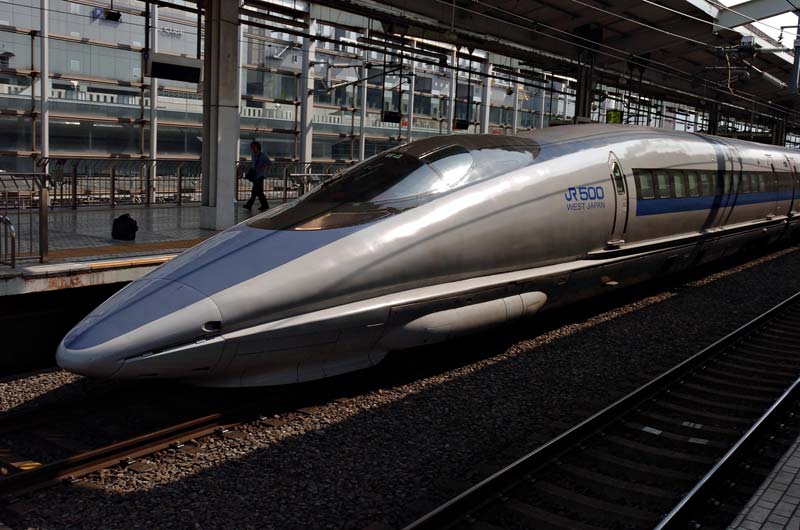
500 Series Shinkansen
2) Just as
Great Britain was a birthplace of locomotives in the 19th
century, Japan
became a high-speed pioneer in the 20th
century. By the 1960s railways were regarded in many countries as an
outdated mode of transport with slow train speeds and steam traction
still around. October 1964, when the world’s first high-speed line
Tokaido Shinkansen opened to the public, became a pivotal point in
railway development. The
bullet train
(called so
because of its stream-lined shape and the speed of 210km/h) was a
major leap forward in railway technology and paved the way for
high-speed rail (HSR) revolution now sweeping through Asia and
Europe. At present Japan has the most heavily travelled, and the
largest HSR network in the world.
(3) Typically, high-speed trains travel at top speeds of between 250km/h (on upgraded conventional lines) and over 300km/h (on new dedicated lines). The world record for a wheeled train was set in 2007 by a French TGV that reached a speed of 575km/h. Japan is still in the vanguard of high-speed R&D with the world’s fastest experimental Maglev train (the absolute train speed record of 581km/h). The Maglev train based on the principle of magnetic levitation can be likened to a flying train or a guided aircraft, supported by the force of powerful magnets. The train is not in commercial operation yet, and high costs remain as barriers. Anyway, Maglev technology is often called the rail industry’s rising star.
(4) Europe’s railways entered the high-speed era at the beginning of the 1980s. The acronyms1 and branding such as TGV, ICE and AVE have become familiar to rail travellers and general public.
France has perhaps the most developed high-speed network in Europe. The TGV (Train à Grande Vitesse) network started in 1981 with the opening of Europe’s first dedicated high-speed line between Lyon and Paris.
T
The TGV is
the workhorse of France’s high-speed network.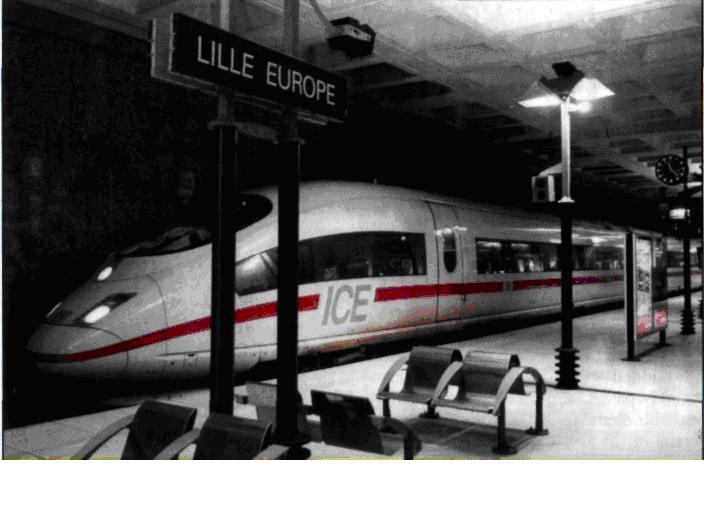 here
have been three generations of TGV, two single-deck, and the Duplex
double-deck
version. The first generation of TGVs
in 1981 mastered the high speed of 270km/h. The second generation in
1989 mastered comfort at high speed. The third
Duplex
generation TGVs
from 1997 mastered comfort, capacity, and economy at the speed of
320km/h. Currently Alstom is building a radical new design of TGV
called AGV.
The fourth generation of TGV will take advantage of the latest
advances in technology and will meet the new Technical Specifications
for Interoperability (TSI)2
for high-speed trains. The f
here
have been three generations of TGV, two single-deck, and the Duplex
double-deck
version. The first generation of TGVs
in 1981 mastered the high speed of 270km/h. The second generation in
1989 mastered comfort at high speed. The third
Duplex
generation TGVs
from 1997 mastered comfort, capacity, and economy at the speed of
320km/h. Currently Alstom is building a radical new design of TGV
called AGV.
The fourth generation of TGV will take advantage of the latest
advances in technology and will meet the new Technical Specifications
for Interoperability (TSI)2
for high-speed trains. The f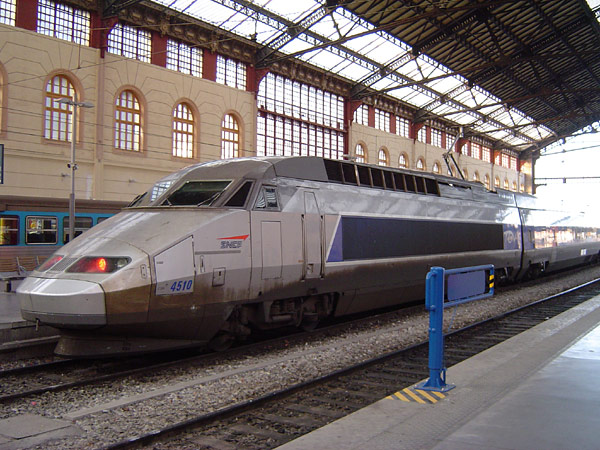
(5) In Germany, high-speed operation commenced in 1991 with InterCity Express (ICE) trains. Starting in 2000, multisystem third-generation ICE trains entered the Netherlands and Belgium. The third generation of the ICE developed by Siemens reaches a speed up to 363km/h.
(6) In the United Kingdom, Eurostar trains which run through the Channel Tunnel between the UK and both France and Belgium, are modified versions of the TGV trains. The first Eurostars entered service in 1994 and immediately started to compete strongly against air. Within a short time, Eurostar has captured a 69% market share on the London–Paris axis, which had one of the busiest air corridors in Europe. A fully loaded train of 794 passengers is equivalent to seven Boeing 737s. It is also the only train service in the world with airline-style check-in3 procedures imposed for security.
Section 1 of the Channel Tunnel Rail Link (CTRL) has a line speed of 300km/h and is concerned mostly with international trains. The opening of phase two of the CTRL2 in 2007 will provide journey times of 1h 20min to Lille, 1h 51min to Brussels, and 2h 15min to Paris. Many French people work in London during the week, and at weekends about 80% of them use Eurostar (which runs every half an hour) to get back to France.
(7) The AVE (Alta Velocidad Española) high-speed rail network in Spain was started with the opening of Madrid-Sevilla route in 1992.
T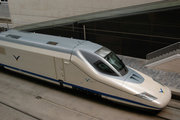 he
latest Spanish high-speed train Velaro
with a top speed of 350km/h is the fastest series-produced train
worldwide travelling 600km between Barcelona and Madrid in only 2.5
hours. The Spanish government has also entered into several
agreements with France and Portugal in accordance with the European
strategic goal – to connect all the major European cities by
high-speed rail.
he
latest Spanish high-speed train Velaro
with a top speed of 350km/h is the fastest series-produced train
worldwide travelling 600km between Barcelona and Madrid in only 2.5
hours. The Spanish government has also entered into several
agreements with France and Portugal in accordance with the European
strategic goal – to connect all the major European cities by
high-speed rail.
(
T he
state-of-the-art modular trains, which are designed to meet European
interoperability standards, come in two versions: a tilting
Pendolino,
and non-tilting train for 250km/h
shuttle
services.
Alstom’s
Pendolino is by far the market leader with its sophisticated
elect-ronics,
extensive computerization and tilt system. Journey times have been
dramatically reduced by the Pendolino which is almost as fast on
curves as it is on the straight lines, and can run on standard tracks
he
state-of-the-art modular trains, which are designed to meet European
interoperability standards, come in two versions: a tilting
Pendolino,
and non-tilting train for 250km/h
shuttle
services.
Alstom’s
Pendolino is by far the market leader with its sophisticated
elect-ronics,
extensive computerization and tilt system. Journey times have been
dramatically reduced by the Pendolino which is almost as fast on
curves as it is on the straight lines, and can run on standard tracks
(9) The major passenger carrier in the United States, Amtrak, has been operating Acela Express trains on the northeast corridor between Boston, New York and Washington since 2000.
These trains tilt on curves along the track, the average speed being about 132km//h (which is much lower than that in Europe or Asia). The Acela train has definite similarities to its ‘parent’, the TGV train, using existing and proven technologies from Bombardier and Alstom.
(10) The HSR map of the world is increasingly expanding now. Membership of the once highly exclusive HSR club is steadily growing. The length of the HSR network will more than double worldwide in the next 10 years, increasing to 14,400km by 2015. This decade will see the completion of the majority of the European high-speed network in France, Germany, Spain, Belgium, Italy, Britain, and the Netherlands. Taiwan has just joined the Asian high-speed club, following Japan and Korea. China Star, the first high-speed train produced in China using its own intellectual rights, has successfully completed a series of tests. China has the world’s only commercial Maglev line.
(11) As for Ukraine, it only makes its first steps in this direction. In 2002, the first express train of higher comfort Capital Express departed from Kharkiv to Kyiv. Since then, some more expresses have entered service on the most popular routes. Convenient carriages of the first and business class, attractive interior, perfect service and few intermediate stops make the journey not only faster but more pleasant as well.
(12) Мuch of the technology behind HSR is compatible with existing infrastructure. The trend in Europe seems to be away from dedicated high-speed passenger railways towards mixed traffic lines for maximum benefit. Mixed traffic lines are usually reserved for high-speed passenger trains during the daytime, while freight trains go at night.
(13)
The last generation of high-speed trains is designed to improve ride
quality, reduce noise and consume less energy, and thereby be more
environmentally friendly. New technical developments are leading to
lighter, more-aerodynamic trains, which cost less per seat to
ope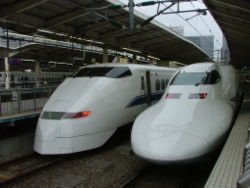 rate.
rate.
The Japanese N700, planned for service in 2007, incorporates the latest technologies, such as inter-car hoods5 to reduce external noise, a nose shape with superior aerodynamic performance. It is also the first Shinkansen train to feature an air-spring-based tilting system6 which allows the train to operate at higher speeds through curves. The double-wing nose shape (so called because of its resemblance to a bird) was developed on the basis of the latest analysis technology, used in the development of aircraft wings, for the first time in a rail vehicle.
A
new generation
of
Shinkansen trains FASTECH
360 with
a top speed of 405km/h is currently under development. Its name is a
combination of Fast, Technology,
and
the operational speed of 360 km/h. FASTECH 360 trains are equipped
with ear-like air brakes for emergency halt protruding7
from the r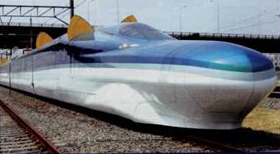 oof.
In Japan the train got a nickname ‘cat-eared Shinkansen’. FASTECH
360 trains will have an arrow-line shape with a ‘duck-bill nose’.
Like most high-speed trains, FASTECH 360 will have distributed
traction instead of power cars. The modular concept implies grouping
cars in two three-car sections linked together with a so-called key
car. Production trains are expected to enter service in 2011.
oof.
In Japan the train got a nickname ‘cat-eared Shinkansen’. FASTECH
360 trains will have an arrow-line shape with a ‘duck-bill nose’.
Like most high-speed trains, FASTECH 360 will have distributed
traction instead of power cars. The modular concept implies grouping
cars in two three-car sections linked together with a so-called key
car. Production trains are expected to enter service in 2011.
1 acronym – акронім (слово, що сформовано з перших літер словосполучення)
2 Technical Specifications for Interoperability (TSI) – технічні вимоги до експлуатаційної сумісності
3 check-in procedures – процедура реєстрації
4 lean into a bend – нахилятися на схилах
5 inter-car hoods – міжвагонний обтічник
6 air-spring-based tilting system – пневматична система нахилу кузова
7 protruding – що виступають
Exercise 23 Answer the following questions.
1. What are the advantages of high-speed trains over automobiles and aircraft? 2. Which country is the world’s high-speed pioneer? 3. Why was the year of 1964 a pivotal point in the railway development? 4. Which speeds are common on upgraded conventional lines now? What is the high-speed standard for dedicated lines? 5. Is Japan still in the vanguard of high-speed R&D? How can you prove it? 6. What is the world speed record for a wheeled train? 7. What is the world speed record for experimental Maglev train? 8. When and where did the first European high-speed line appear? 9. How many generations of TGV trains do you know? How do they differ? 10.Which countries are connected with TGV network? 11. When did Germany commence high-speed operation? 12. What is an Eurostar train? 13.What is the journey time from London to Paris and Brussels by Eurostar? 14. How is HSR developing in Spain? 15.What is the main passenger carrier in the USA? Which trains does it operate? 16. What concept is Pendolino train based on? 17. What is one of the characteristic features of tilting trains? 18. How is the high-speed map of the world expanding? 19. Which countries will join the Asian high-speed club in the nearest future? 20. Are there high-speed trains in Ukraine? 21. What features do the latest high-speed train possess? 22. What will be the main advantage of the N700 tilting train? 23. What does the modular concept of the latest high-speed trains imply? Why is FASTECH 360 nicknamed ‘cat-eared Shinkansen’? 24. What is the trend in operating HSR in Europe? 25. Can you name the major railway producers and manufacturing companies in Europe?
Exercise 24 Complete the sentences with the following words:
purpose-built, consume, guided, captured, state-of-the-art, dedicated, boosting,
pivotal, tilting, commenced, likened, bullet, compatible, ride quality, mastered
1. The first generation of TGVs … high-speed. 2. French Railways deploy a new generation Super-TGV on … infrastructure. 3. Germany … its high-speed operation in 1991. 4. Eurostar has … a 69% market share on London-Paris axis. 5. Italian … vehicles have been developed with Tiltronix technologies. 6. High-speed stations are the main stimulus for … economy. 7. A … train was a beacon of hope for both Japanese and world railways. 8. Japan’s Tokaido Shinkansen Railway is the first … high-speed line in the world. 9. The new modular trains come in two versions: a … Pendollino and non- … train. 10. October 1964 became a ... point in railway development. 11. Maglev trains can be … to a flying train or a … aircraft. 12. Much of the technology behind HSR is … with existing infrastructure. 13. The last generation of high-speed trains is designed to improve …, reduce noise and … less energy.
Exercise 25 Are these sentences true or false? Correct the false sentences with the facts from the text.
1. At present France has the most heavily travelled, and the largest HSR network in the world. 2. Japan pioneered high-speed transportation in 1964. 3. There have been four generations of TGV in France by now. 4. The Maglev train is in commercial operation already. 5. Currently the TGV network consists of six high-speed lines. 6. Europe’s railways entered the high-speed era at the beginning of the 1990s. 7. Eurostars cannot compete successfully against air. 8. Tilting trains have been widely used in Italy because its mountainous geography influences the roads and railway tracks. 9. The Pendolino is not so fast on curves as it is on the straight lines, and can run only on dedicated tracks. 10. American high-speed trains are as fast as European ones. 11. Membership of the highly exclusive HSR club is limited by European countries. 12. Ukraine will soon enter the HSR club. 13. Much of the technology behind HSR is incompatible with existing infrastructure.
Exercise 26 Find the appropriate description for the following words.
a) congestion b) service c) a bogie d) a curve e) traffic g) a route f) version h) currently i) a schedule j) a crossing |
1) a form or variant of a type or original 2) an established or selected course of travel or action 3) something that is occurring or existing presently 4) a plan indicating the time and sequence of each operation 5) overfullness of trains and other vehicles 6) the labour performed for another, duty done or required 7) a vehicle’s movement through an area or along a route 8) a place or structure for crossing the road 9) a driving-wheel unit 10) a part of the track that is hook-shaped or bent |
Exercise 27 Look through the text attentively again and fill in the chart.
Train type |
Country of origin |
Top speed |
Cities connected |
Special features |
AVE |
|
|
|
|
TGV |
|
|
|
|
ICE |
|
|
|
|
Pendolino |
|
|
|
|
Acela |
|
|
|
|
Maglev |
|
|
|
|
Eurostar |
|
|
|
|
Direttissima |
|
|
|
|
China Star |
|
|
|
|
N700 |
|
|
|
|
FASTECH 360 |
|
|
|
|
AGV |
|
|
|
|
Exercise 28 Write a summary of the text, presenting the content of each paragraph in 2-3 sentences. Use the expressions:
The main idea of the text is ...
The text deals with one of the most important (urgent) issues ...
Much attention (consideration) is given to (classification, description) ...
It focuses on the matters of ...
The text gives an overview of ...
The text is mainly concerned with ...
The aim of the survey is to show (demonstrate, find)...
Particular emphasis is given to the analysis of…
The text gives a detailed analysis of (reports on) ...
To sum up ...
In conclusion ...
Be ready to give an oral presentation of it.
Exercise 29 You are a participant of the international scientific conference ‘European HSR’. Make a report basing on the text (or any other source including Internet) and present it to the audience. Remember that there are some universal rules and language to build and frame your report.
Opening phrases: Dear friends (colleagues)! Honoured members of the organizing committee! It’s my privilege today to be talking to professional experts in this field. I represent …
Stating the target: The goal of my report / This presentation is to discuss the issues of (to review, to consider, to highlight, to analyse) …
Besides, I am going to focus on the matters of …
I would like to give special emphasis to …
I am here to report on the latest developments in…
That brings me to the next point.
Well, now we’ve given the main outline, we can ...
Conclusion: Now let me summarize the main points. (To sum up)…
Well, I think that covers it.
That’s about all I wanted to say. Thank you for your attention. If there are any questions, I’ll be glad/happy to answer them.
It is my very great pleasure to thank you on behalf of this meeting . Just before we break up, may I on behalf of …, say a few words of thanks to ...
Use the following phrases to present and develop your arguments:
personally, obviously, what is more, that is why, generally speaking, another point is that, all things considered, on the one hand (on the other hand), to sum up, one (dis)advantage is that, for instance, to my mind, finally, on the plus side, however.
Exercise 30 Read the text and summarize all the pros and cons of HSR. You may add your own arguments for or against.
